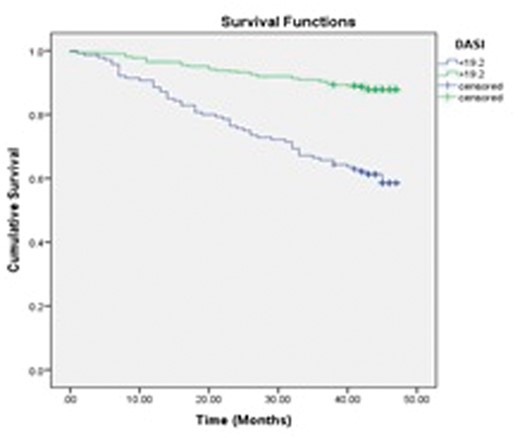-
PDF
- Split View
-
Views
-
Cite
Cite
Amy Clarke, Thomas Yates, Douglas Gould, Katherine Hull, Alice Smith, James Burton, MP464
SELF-REPORTED PHYSICAL FUNCTION PREDICTS ALL-CAUSE MORTALITY IN PATIENTS WITH CHRONIC KIDNEY DISEASE, Nephrology Dialysis Transplantation, Volume 32, Issue suppl_3, May 2017, Page iii599, https://doi.org/10.1093/ndt/gfx173.MP464Close - Share Icon Share
INTRODUCTION AND AIMS: Reduced physical function is associated with an increased risk of all-cause mortality among CKD patients not requiring renal replacement therapy (RRT). Routine physical performance assessments can help to identify those at risk for adverse events. However, objective measures are not always feasible, and self-reported measures may provide a suitable surrogate.
METHODS: We examined the association between self-reported physical function and survival in patients with CKD not requiring RRT. 450 CKD patients aged 17-93 years were followed up for a median of 44 months. Upon enrolment participants completed the Duke Activity Status Index (DASI) (measure of physical capacity). All-cause mortality events were recorded from electronic records in September 2016. A receiver operating characteristic (ROC) curve was constructed to plot the performance of the DASI continuous scores as a binary classifier for survival in order to identify a potential clinical marker for risk stratification. Sensitivity and specificity analyses were performed to identify the best cut off score to predict all-cause mortality. Kaplan-Meier survival curves and log-rank tests were used to estimate survival proportions. Cox proportional hazard models were constructed to examine the association between DASI score and all-cause mortality in non-adjusted and adjusted models.

MP464 Figure
CONCLUSIONS: This self-reported measure of physical function was independently associated with survival in CKD patients, and may help to identify those at risk for adverse events. Physical function is modifiable and may be an amenable target for interventions to improve outcome in this vulnerable group.





Comments